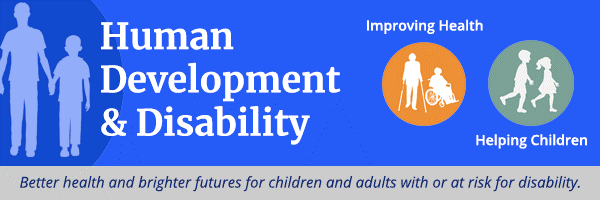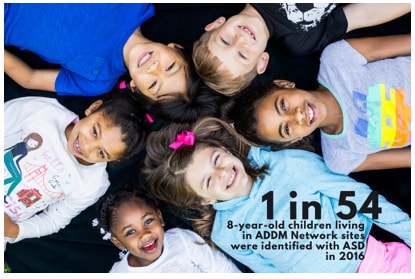DHDD Newsletter – March 2020

A Note from the DHDD Director:
Dear colleagues –
This month I had the opportunity to meet with several of you and hear about the many projects you are involved in and the positive impact those projects are having on the communities we serve. In particular, I met with representatives from the Administration for Children and Families, Special Olympics, Association of University Centers on Disabilities, National Association of Chronic Disease Directors, Trust for America’s Health, National Alliance on Mental Illness, American Academy of Pediatrics, and Autism Speaks. Among other things, we met to discuss the Learn the Signs. Act Early. work, the Early Childhood Health and Development Winnable Battle Innovation Project, and other priority topics related to disability and child development.
I’m now assisting with the COVID-19 response in the role of At-Risk Populations Taskforce lead. This role oversees the policy, communication and science/technical assistance work related to populations at highest risk for severe illness. These include older adults, people with underlying health conditions and some people with disabilities.
Sign up for the COVID-19 newsletter to receive information on the coronavirus disease 2019 (COVID-19) outbreak. Please share with your colleagues and networks
Thank you,
Dr. Georgina Peacock, Director, DHDD
In the Spotlight
New COVID-19 Tools and Resources

COVID-19 resources are now available in American Sign Language (ASL) on CDC’s YouTube page:
- COVID-19 Prevention Tips in ASL
- 10 Things You Can do to Manage COVID-19 at Home
- What is my Risk for COVID-19
- What Older Adults Need to Know about COVID-19
- Symptoms of Coronavirus 2019
Additional resources in ASL will be added in the future as this is a rapidly evolving response. Please continue to refer to CDC’s website for the latest information and please share these links with your contacts!
2020 Community Report on Autism

CDC’s 2020 Community Report on Autism highlights the Autism and Developmental Disabilities Monitoring (ADDM) Network’s most recent findings on autism spectrum disorder (ASD) which show an increase in the prevalence of ASD among 8-year-old children. Based on data reported from 11 sites across the United States, among 8-year-old children, an estimated 1 in 54 was identified with ASD in 2016 as compared to 1 in 59 in 2014. This is the first time the ADDM Network has simultaneously reported data on 4-year-old and 8-year-old children.
- Data reported on 8-year-old children give us a comprehensive picture of the number and characteristics of children identified with ASD.
- Data reported on 4-year-old children tell us more about trends in the early identification of ASD.
Read the following MMWR reports to learn more
- Surveillance Summary: Early Identification of Autism Spectrum Disorder Among Children Aged 4 Years – Early ADDM Network, Six Sites, United States, 2016
- Surveillance Summary: Prevalence of Autism Spectrum Disorder Among Children Aged 8 Years – ADDM Network, 11 Sites, United States, 2016
CDC also offers a web-based platform that provides an in-depth look at autism prevalence estimates by state. The data presented through this website highlight changes over time in reported autism prevalence estimates and in the characteristics of children identified with autism.
CDC and Special Olympics: Inclusive Health

People with intellectual disabilities (ID)— difficulty with thinking, learning, remembering, and reasoning—experience poorer access to quality health care and have poorer health outcomes than people without ID. Read our recent feature on how CDC is working with Special Olympics to improve the health of people with ID.
Also, visit Spread the Word Inclusion website to learn about this campaign and join Special Olympics and Best Buddies in their efforts to inspire respect and acceptance by advocating for inclusive words and actions so that we can end discrimination of individuals with ID.
Publications
Development Among Children with Evidence of Zika Infection

DHDD researchers published a study in Infants & Young Children that describes how the Ages and Stages Questionnaire (ASQ-3) can be used to estimate the degree of developmental delay among children severely affected by Zika virus infection.
Using the adapted ASQ-3 protocol and estimation methods, researchers found that 96% of children with microcephaly in this study had evidence of delay on at least one developmental domain, compared with 13% of children without microcephaly.
In situations where diagnostic evaluation using traditional diagnostic tools is unavailable, clinicians can potentially adapt the ASQ-3 to estimate the severity of developmental delay in a variety of settings and for children across a broad spectrum of severity, including those with profound delay.
Healthy People Law and Health Policy Disability and Health Report

A report from the Office of Disease Prevention and Health Promotion (ODPHP) is the second in a series of reports that highlights the practical application of law and policy to improve health across the nation.
This report, The Role of Law and Health Policy in Achieving Healthy People’s Disability and Health Goals Around Access to Care, Activities Promoting Health and Wellness, Independent Living and Participation, and Collecting Data in the United States, presents evidence-based policy solutions that community and tribal leaders, government officials, public health professionals, health care providers, lawyers, and social service providers can use in their own communities to improve health for people with disabilities. Success stories — or Bright Spots — illustrate how communities have already used law and policy to help meet their health improvement goals and achieve Healthy People’s objectives for people with disabilities.
Collecting Data on Disability and Pregnancy

DHDD’s Dr. JoAnn Thierry is a co-author on a new publication by the National Institutes of Health (NICHD) and CDC entitled Disability and Pregnancy: A Cross-Federal Agency Collaboration to Collect Population-Based Data About Experiences Around the Time of Pregnancy.
As a result of the collaboration between NICHD and CDC, disability status will be among the characteristics that can be described with CDC’s Pregnancy Risk Assessment Monitoring System (PRAMS) data in the future. Researchers and public health professionals can use the new data to better understand the experience of pregnancy for women with disability and help inform clinical guidelines and public health initiatives that reduce barriers to obtaining care for these women.
DHDD In the Field
Partner Meetings in Washington, DC

[Pictured: (left to right) – Wendy Ruben (NCBDDD/OD), Diana Felner (VP, Public Policy, Tourette Association of America), Amanda Talty (President and CEO, Tourette Association of America), and Georgina Peacock (DHDD Director)]
DHDD’S mission is to lead inclusive programs to optimize the health and development of children and adults with, or at risk for, disabilities.
